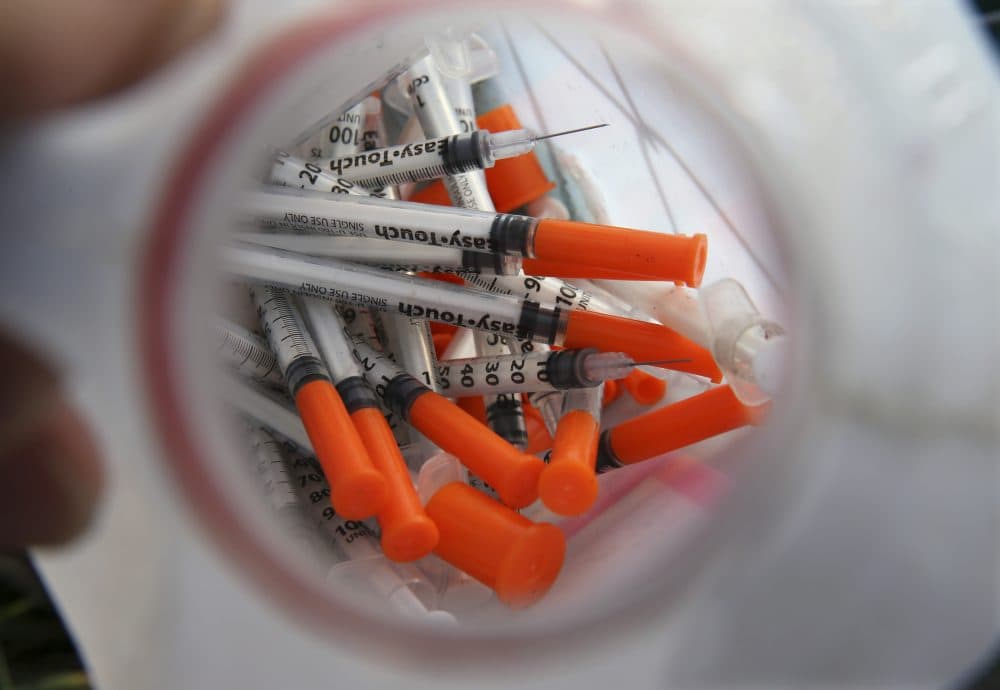Advertisement
If You Inject Drugs, Do You Know The Safe Steps? Try This Quiz

"Who wants to play the trivia game?" asks Meghan Hynes, looking across a room that could be a rec center. Two men nod off at opposite ends of a couch, half asleep or high. A more vigorous group of men and women are settled around a table in the middle of the room, cutting and pasting hearts onto cards.
It’s a Valentine’s Day party at the Needle Exchange and Overdose Prevention program in Cambridge. Amid cookies and soda and sentimental rhymes, Hynes, who manages the program, wants to squeeze in a little education.
"There’s a gift card in it," says Hynes, looking hopeful. A few more people raise their hand, agreeing to participate.
Hynes and Kristin Doneski, the exchange’s outreach coordinator, have packaged information about safe drug use as a set of true/false questions. People who’ve been shooting heroin for years, and those who are new to this addiction, shout out answers. Doneski cheers and tosses candy for each correct response, each tip that might save a life.
We selected 11 of their questions and posted them below. You can test your knowledge, and scroll past the quiz to see detailed answers.
During this epidemic — with five Massachusetts residents dying every day on average after an overdose — we think it’s important to share information that will help drug users avoid infections, related illnesses and death.
Thanks to Dr. Mark Eisenberg for reviewing the medical advice. Dr. Eisenberg is a primary care physician at MGH Charlestown Health Care Center and member of the Addictions Consult Service at MGH.
And Here Are The Detailed Answers...
1. Tap water is safe to use when injecting yourself.
False. Use a sterile liquid: water or saline. Both tap and toilet water are not safe to inject into your blood. When preparing crack, use Vitamin C powder, not lemon juice or vinegar, which are hard on your veins.
2. It is safer to use a lower gauge needle when shooting drugs.
False. The higher the gauge, the smaller the needle, and the lower your risk of damage to veins or your skin.
3. Staying hydrated and doing push-ups will help you find a vein and avoid missing a shot.
True. Tying a tourniquet above the area where you are searching for a vein helps too.
4. Always insert a needle in the direction of your heart.
True. Shooting toward the heart, in the direction of blood flow, will help prevent damage to your veins.
5. The neck and groin are the two most dangerous injection spots on the body.
True. Veins in the groin are very close to the femoral artery and the femoral nerve. Shooting in any artery may be fatal; sticking a nerve can cause nerve damage. Veins, nerves, arteries and tendons are all very close together in the neck. An infection in this area could be life-threatening. If you accidentally hit an artery in your neck, the dose will go directly to the brain and could cause a stroke or other brain damage.
6. If you plan to use a benzodiazepine like Klonopin or Xanax and heroin at the same time, take the pill or pills first.
False. BUT PLEASE AVOID using anything at the same time as heroin because most overdoses are the result of mixing drugs. If you do take a cocktail, use heroin first because the effects are immediate. If you add pills, wait as long as you can and take them one at a time, at least 30 minutes apart. Remember that it may be 30 minutes or more before a pill takes effect and it the effect will last for hours. Both heroin and benzos slow breathing, which is part of the reason the combined effect can be deadly.
7. Speedballing (taking heroin and cocaine at the same time) is safer than using heroin alone.
False. Mixing drugs increases your risk of a fatal overdose.
8. All naloxone available at a pharmacy delivers the same dose.
False. There are three home use naloxone options:
- The naloxone kit (pictured here) contains two syringes, each with 1 milligram.
- 2. The auto-injector delivers a 2-milligram dose.
- 3. The single step nasal spray has 4 milligrams.
9. Naloxone can be used to reverse a methadone overdose.
True. Naloxone can be used to reverse any opioid overdose, although you may need a large dose and several injections if the person used fentanyl.
10. Hepatitis C can be shared through cookers and cottons.
True. Hep C can survive for up to two weeks in cookers and on cottons. Don't share needles, cookers or cottons.
11. HIV is transmitted through all of these fluids: semen, blood, vaginal secretions, breast milk.
True.
